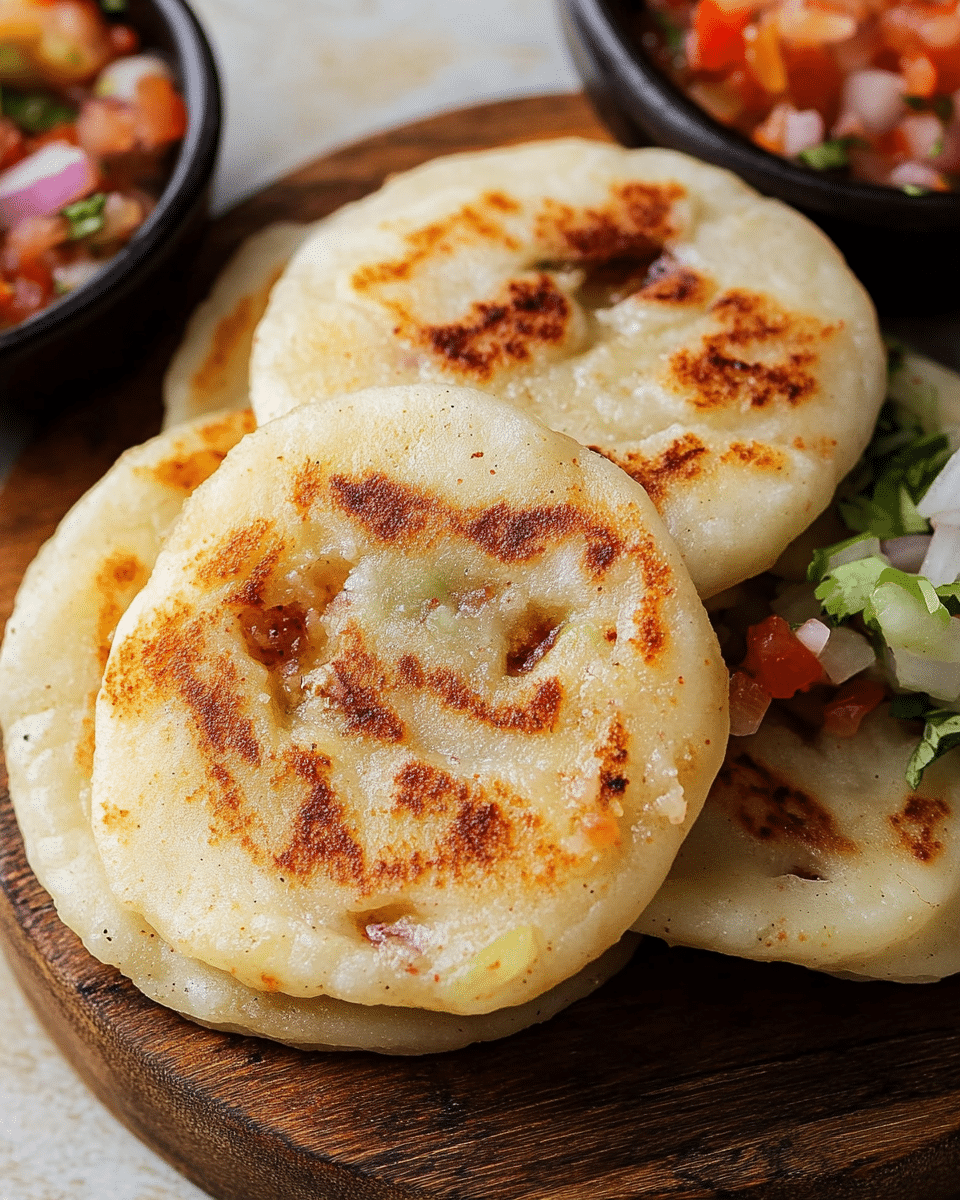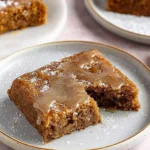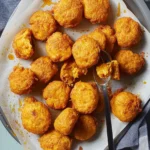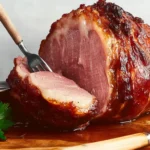Pupusas are a beloved traditional Salvadoran dish made from masa harina stuffed with gooey cheese or beans, cooked on a hot griddle until perfectly golden. They’re rustic yet comforting, with a flavor that immediately warms the heart and satisfies the soul. Served with curtido, a crunchy, tangy slaw and rich salsa roja, the dish balances textures and flavors beautifully.
This meal is more than just food, it’s a cultural experience. Each bite of a pupusa gives you a taste of tradition, bringing together savory fillings, hearty masa, and vibrant toppings. Whether you’re cooking for family dinner, meal-prepping for the week, or introducing your taste buds to Salvadoran cuisine, pupusas are guaranteed to be a hit.
Full Recipe:
Ingredients:
For the Pupusas:
-
2 cups masa harina (corn flour)
-
1 ½ cups warm water (plus more if needed)
-
1 teaspoon salt
-
1 cup shredded mozzarella cheese (or queso Oaxaca)
-
½ cup refried beans (optional, for filling)
For the Curtido (Slaw):
-
2 cups shredded cabbage
-
1 carrot, grated
-
½ small onion, thinly sliced
-
1 cup boiling water
-
½ cup apple cider vinegar
-
1 teaspoon dried oregano
-
½ teaspoon red pepper flakes
-
½ teaspoon salt
For the Salsa Roja:
-
4 ripe tomatoes, chopped
-
½ onion, chopped
-
2 cloves garlic
-
1 tablespoon vegetable oil
-
1 teaspoon ground cumin
-
Salt and pepper to taste
Directions:
-
Prepare the Curtido: Place cabbage, carrot, and onion in a bowl. Pour boiling water over them and let sit for 5 minutes, then drain. Mix with vinegar, oregano, red pepper flakes, and salt. Refrigerate until ready to serve.
-
Make the Salsa Roja: Heat oil in a skillet, then sauté tomatoes, onion, and garlic for 5 minutes. Blend until smooth. Return to skillet, add cumin, salt, and pepper, then simmer for 10 minutes. Set aside.
-
Form the Pupusa Dough: In a large bowl, mix masa harina, salt, and warm water until a soft dough forms. Add more water if crumbly.
-
Shape Pupusas: Divide dough into 8 balls. Flatten each ball, add cheese (and beans if using), then seal and pat gently into a disc.
-
Cook Pupusas: Heat a lightly oiled skillet or griddle over medium heat. Cook pupusas for 3–4 minutes per side until golden and slightly crispy.
-
Serve hot with curtido and salsa roja on the side.
Prep Time: 20 minutes | Cooking Time: 25 minutes | Total Time: 45 minutes
Kcal: 280 kcal | Servings: 4 servings
Salvadoran Pupusas with Curtido and Salsa Roja
If there’s one dish that perfectly captures the warmth and heart of Salvadoran cuisine, it’s pupusas. These handmade corn cakes, stuffed with cheese, beans, or meat, are a staple in El Salvador and have steadily gained popularity across the globe. The magic of pupusas lies in their simplicity: just masa harina (corn flour), water, salt, and a filling of choice. Yet when cooked on a hot griddle until golden brown, and served alongside tangy curtido and smoky salsa roja, they transform into a dish that feels comforting, filling, and deeply rooted in tradition.
Pupusas are more than just food, they are a piece of cultural identity. In fact, El Salvador has even declared them the national dish, celebrating them every second Sunday of November on National Pupusa Day. From bustling street markets to family gatherings, pupusas bring people together around the table, offering both nourishment and connection.
A Brief History of Pupusas
The origins of pupusas stretch back centuries to the indigenous Pipil tribes of El Salvador. Early versions were made using basic tools and ingredients that were readily available, such as corn and beans. Over time, Spanish influence introduced cheese and meats, diversifying the fillings while preserving the dish’s original character.
Traditionally, pupusas were made by hand, a process that continues today. Salvadoran women would gather in kitchens and open-air stalls, patting dough between their palms before cooking it on a comal (a flat griddle). This tactile method of preparation isn’t just practical, it’s symbolic of the care and effort poured into family meals.
As Salvadorans migrated worldwide, especially to the United States, they brought pupusas with them, leading to their increasing popularity in cities like Los Angeles, Washington, D.C., and Houston. Today, pupusas are enjoyed not only within the Salvadoran community but also by food lovers everywhere seeking authentic, homemade comfort food.
The Essential Components of Pupusas
A truly delicious pupusa is more than just its filling. The dish is a combination of three key elements:
-
The Pupusa Itself – Made from masa harina, a finely ground corn flour that is nixtamalized (treated with lime), which gives it a distinct flavor and texture. When hydrated and kneaded, the masa transforms into a soft dough, pliable enough to shape and stuff without breaking apart.
-
Curtido (Pickled Slaw) – This crunchy side dish is a refreshing contrast to the richness of pupusas. Typically made with cabbage, carrots, onions, vinegar, and oregano, curtido provides tang, crunch, and acidity, cutting through the cheesy, savory flavors of the corn cakes.
-
Salsa Roja – A simple yet flavorful tomato-based sauce that ties the dish together. With onion, garlic, and a touch of cumin, it delivers smoky depth and a hint of sweetness. Served warm or at room temperature, salsa roja is poured generously over pupusas before eating.
Together, these three elements create a balanced plate, comforting, tangy, and satisfying.
Variations of Pupusas
One of the best aspects of pupusas is how customizable they are. While the most traditional versions stick to a few fillings, modern interpretations allow for creativity while still respecting the dish’s roots. Here are the most common varieties:
-
Pupusas de Queso – Filled with melted cheese, usually mozzarella or queso Oaxaca, these are the most beloved and classic pupusas.
-
Pupusas de Frijoles – Stuffed with refried beans for a creamy, earthy filling.
-
Pupusas Revueltas – A combination of cheese, beans, and sometimes pork (chicharrón), making them hearty and flavorful.
-
Pupusas de Loroco – Made with loroco, an edible flower native to Central America, giving a unique, floral, and earthy flavor.
-
Vegan Pupusas – Swapping in plant-based cheese or vegetable fillings like sautéed mushrooms, spinach, or zucchini makes this dish accessible to everyone.
Restaurants and street vendors often mix and match fillings to cater to different tastes, and at home, you can experiment with seasonal produce or different cheeses.
Tips for Making Perfect Pupusas
If you’re new to making pupusas, the process may seem intimidating, but with practice, it becomes second nature. Here are some tips to ensure success:
-
Get the dough texture right – Masa should be soft and pliable but not sticky. If it cracks when forming discs, add a splash of water.
-
Seal fillings carefully – To prevent cheese or beans from leaking, ensure the edges are tightly sealed before flattening.
-
Cook on medium heat – Too high, and the outside burns before the inside cooks. Medium heat allows the pupusa to cook evenly and develop a golden crust.
-
Serve fresh – Pupusas taste best hot off the griddle, with gooey cheese and warm fillings.
Serving Suggestions
While pupusas are traditionally served with curtido and salsa roja, you can expand the meal into a feast by pairing them with:
-
Black beans and rice for a heartier plate.
-
Grilled meats like chicken or beef to create a fusion meal.
-
Avocado slices or guacamole for added creaminess.
-
Hot sauce for spice lovers who want extra kick.
Pupusas also make an excellent party dish. You can prepare the dough and fillings ahead of time, then cook them fresh when guests arrive. The interactive process of patting and stuffing the masa can even turn into a fun group cooking activity.
Nutritional Benefits
While pupusas are undeniably indulgent, they also provide nutritional value. Masa harina is naturally gluten-free, making pupusas a safe option for those with gluten sensitivities or celiac disease. Corn is also a good source of fiber, magnesium, and essential vitamins.
The cheese adds protein and calcium, while fillings like beans increase fiber and plant-based protein. When served with curtido, you get additional vitamins and probiotics from the pickled cabbage. Salsa roja contributes antioxidants from tomatoes and garlic.
Of course, moderation is key, pupusas are hearty and calorie-dense, so pairing them with lighter sides helps maintain balance.
Pupusas in Modern Cuisine
As Salvadoran food gains recognition worldwide, pupusas are appearing on restaurant menus far beyond Central America. Chefs are experimenting with fillings like roasted vegetables, spicy chorizo, and even fusion versions with global flavors such as kimchi or curry.
Despite these modern adaptations, the heart of the dish remains the same: a warm, cheesy, corn-based cake that celebrates tradition while welcoming innovation. For many Salvadorans abroad, pupusas are a taste of home, a reminder of family gatherings, and a source of cultural pride.
Conclusion
Pupusas are much more than a meal, they are a tradition, a comfort, and a cultural symbol. With just a handful of simple ingredients, they offer warmth, satisfaction, and a connection to Salvadoran heritage. When paired with curtido and salsa roja, they strike the perfect balance of rich, tangy, and savory flavors.
Whether you’re trying pupusas for the first time or recreating a family classic, this dish will quickly earn a place in your kitchen. They’re versatile, filling, and deeply rewarding to make. So, roll up your sleeves, get your masa ready, and bring a little Salvadoran flavor to your table. Your taste buds and your family will thank you.






